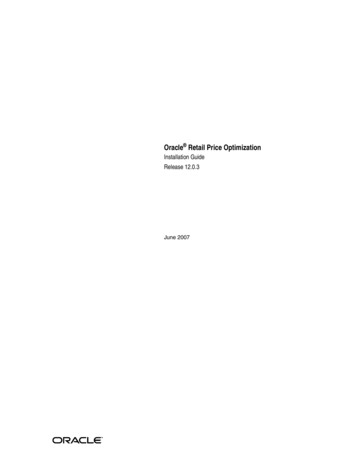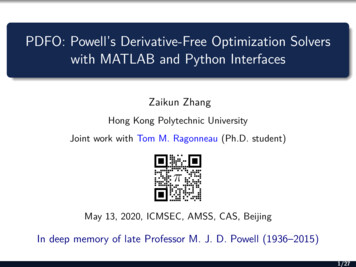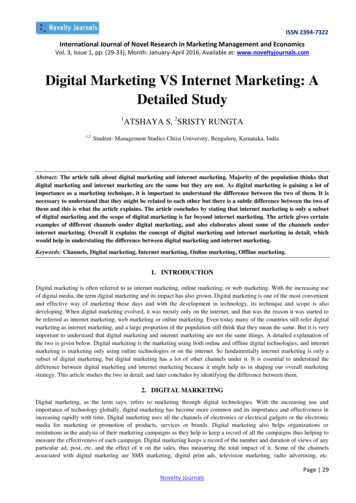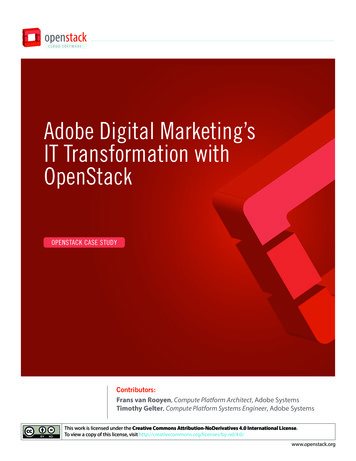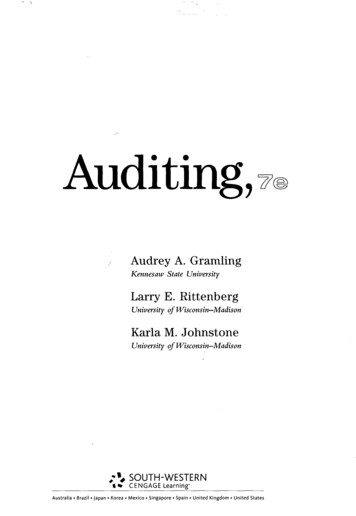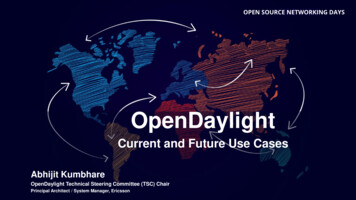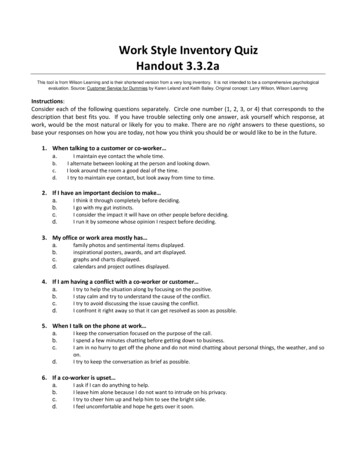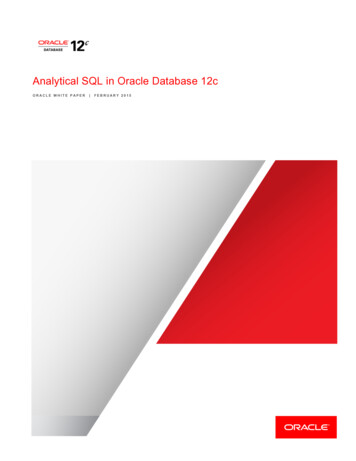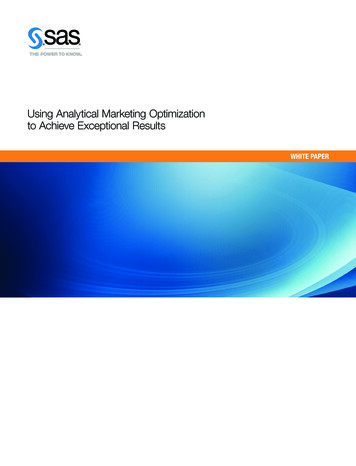
Transcription
Using Analytical Marketing Optimizationto Achieve Exceptional ResultsWHITE PAPER
SAS White PaperTable of ContentsOptimization Defined . . . . . . . . . . . . . . . . . . . . . . . . . . . . . . . . . . . . . . . 1Prioritization, Rules and Optimization – a Method Comparison . . . . 2Prioritization . . . . . . . . . . . . . . . . . . . . . . . . . . . . . . . . . . . . . . . . . . . . . 3Rules . . . . . . . . . . . . . . . . . . . . . . . . . . . . . . . . . . . . . . . . . . . . . . . . . . . 4Optimization. . . . . . . . . . . . . . . . . . . . . . . . . . . . . . . . . . . . . . . . . . . . . . 5The SAS Approach to Marketing Optimization. . . . . . . . . . . . . . . . . . . 6Organizational Considerations. . . . . . . . . . . . . . . . . . . . . . . . . . . . . . . . 7Standard Reports and Sensitivity Analysis. . . . . . . . . . . . . . . . . . . . . . 8Extending Optimization with Business Intelligence. . . . . . . . . . . . . . . 8Balancing Suppression Rules and Constraints . . . . . . . . . . . . . . . . . . . 8Success with SAS Marketing Optimization . . . . . . . . . . . . . . . . . . . . 9Summary . . . . . . . . . . . . . . . . . . . . . . . . . . . . . . . . . . . . . . . . . . . . . . . . . 9Learn More. . . . . . . . . . . . . . . . . . . . . . . . . . . . . . . . . . . . . . . . . . . . . . . . 9
Using Analytical Marketing Optimization to Achieve Exceptional ResultsOptimization DefinedThe complexity of direct marketing has expanded rapidly in recent years, particularlywith the growth of digital marketing channels. Companies today have to make difficultdecisions about targeting the right customers with the right offers while staying withinbudget and channel capacities, all without cannibalizing future sales or saturatingcustomers with too many messages. That is a lot to manage, particularly when multiplecampaigns from one company might also be competing for customers’ attention.Optimization resolves these complex issues by looking at problems in a holistic fashionthat balances the constraints of an organization with the need to improve key metrics.Unlike traditional business-rule methods for allocating campaigns to customers,optimization allows marketers to gain critical knowledge about factors that affect thesuccess of marketing campaigns – such as the impact of adding a new channel, theprobable results of reducing a budget or the consequences of instituting a strategiccontact policy.The best way to explain the differences between traditional approaches and optimizationis through example. This paper will use an example in order to: Show the value associated with taking an optimization approach to directmarketing. Discuss organizational challenges common when implementing optimization. Detail the SAS approach to marketing optimization.1
SAS White PaperPrioritization, Rules and Optimization – a Method ComparisonThe following example illustrates problems that can arise when companies executecustomer-based campaigns where there are limits on which customers are eligible toreceive offers. In cases where one customer only qualifies for one offer, the solution issimple – the customer gets that offer. The problem becomes more challenging, however,when there is a group of customers that qualify for more than one offer.Figure 1 shows this situation. Overlapping sections in the diagram represent customerswho qualify for multiple offers. When optimizing across time periods, the overlap canincrease exponentially. What makes offer allocation decisions even more importantis that customers who qualify for more than one offer are often the most valuablecustomers. Poor decisions about campaign allocation could jeopardize that value.Campaign ACampaign BCampaign CFigure 1: Overlapping sections represent customers who qualify for multiple offers.Companies approach this problem in different ways. In the following example, we willcompare three approaches: prioritization, rules-based and optimization. The first thingmany companies do when attempting to make a decision about offer allocation is todevelop model scores that reflect the probability of response for given customers andgiven campaigns. These model scores, in addition to other values such as the expected2
Using Analytical Marketing Optimization to Achieve Exceptional Resultsrevenue from a response, make up an expected value. Table 1 shows the expectedvalues for each customer-campaign combination. Execution of this campaign also hastwo constraints: Each campaign can be sent, at most, to three customers in the list. Each customer can receive only one campaign.PrioritizationPrioritization is the most common approach database marketers take to solve thisproblem. Put simply, prioritization assigns an order of priority for each campaign beingconsidered within the same time period. For example, it may have been determinedthat Campaign A is the best-performing campaign available. Therefore, it will get itsfirst choice of customers and will choose customers 1, 7 and 9 because they offer thehighest expected values available.Campaign B will get the best customers remaining, and Campaign C will get the rest.Table 1 shows the results of the prioritization method. Shaded cells mark the customerschosen to receive each campaign. Using this approach, the company can expect 655in profit for the three campaigns.By looking carefully at the customers chosen for each campaign, you can clearly seethat there is room for improvement. Specifically, it is logical to think that Customer 1should have received Campaign B, which would have resulted in an improvement of 20. Campaign selection based on this type of reasoning is shown below.CustomerCampaign ACampaign BCampaign 0758656060980110?75 655Expected Return:Table 1: Results of the prioritization method.3
SAS White PaperRulesBased on what we learned about prioritization, the logical question becomes: Why notgive each customer the offer that will result in the most revenue? This question describesthe rules-based approach. This approach establishes rules that look at each customer inorder to determine the appropriate campaign for that customer.In our example, Customer 1 will get Campaign B, Customer 2 will get Campaign C andso on. This seems like a major improvement over prioritization, and in some cases itis. However, the drawback of this approach is that if revenue opportunities exist furtherdown the list of customers, the marketer may not be able to target them because ofconstraints. Remember that each campaign can go to a maximum of three customers.Because of this constraint, Customer 9 cannot get Campaign B, even though it wouldbe a better choice. The rules-based approach would result in a 715 profit for thisorganization.CustomerCampaign ACampaign BCampaign 758656060980110?75Table 2: Results of the rules-based approach.4Expected Return:715 60Improvement:
Using Analytical Marketing Optimization to Achieve Exceptional ResultsOptimizationThe use of operations research techniques enables the best allocation of customers tocampaigns. This method takes opportunity cost into account with the knowledge thatextending an offer to any particular customer could prevent a better offer from beingpresented. Evaluating all combinations simultaneously will result in the best possiblesolution. In this case, a profit of 745 was achieved using the same customers and thesame campaigns. This represents an improvement of more than 13 percent over theprioritization method.CustomerCampaign ACampaign BCampaign 75865606098011075Expected Return: 745 30 90Improvement (business rules):Improvement (prioritization):Table 3: Results of mathematical optimization.While a detailed look at the mathematical methods for optimization is not within thescope of this paper, it is important to note two things. First, this simple example doesnot reflect the enormity of typical marketing optimization problems. Many companiesface similar situations with millions of customers, dozens of campaigns, complexconstraints and sophisticated contact policies. When the scale of the problemincreases, so does the opportunity for improvement. Many large organizations haveseen improvements of greater than 25 percent.Second, the computational power necessary to solve such complex problemstraditionally has been a bottleneck. Intensive research by a team of operations researchscientists and domain experts has yielded a breakthrough algorithm that solves largescale problems efficiently. Due to these innovative approaches, SAS allows marketersto solve these problems in a time frame that is reasonable and flexible enough to fit theobjective.5
SAS White PaperThe SAS Approach to Marketing OptimizationAs mentioned above, any optimization exercise will consist of an objective, a set ofconstraints and a contact policy. SAS Marketing Optimization allows marketers whoknow nothing about optimization techniques to construct a scenario with these threecomponents and then optimize campaigns for execution.Objective – The objective for a marketing optimization problem can be defined in manyways, depending on the overall goals of the campaign. If the overall goal is to increaseprofitability, the marketer can choose profit as the metric to be maximized. SAS providesflexibility in the goals of the campaigns so that the optimized value can be the result ofan equation of two or more metrics. In other cases, the marketer might set an objectiveto minimize, such as risk or cost.Constraints – Constraints enable marketers to specify key marketing limits such asminimums or maximums for spending. Constraints can also be set at the customersegment level. Such constraints can involve: Budget. Set the budget constraints for any or all campaigns. In addition, budgetconstraints can be created at the individual communication level. Cell size. Very often, campaigns need to be a certain size to be worth executing.Marketers can create constraints that reflect the real nature of the direct marketingworld through minimum or maximum cell sizes. Channel capacity. Outbound and inbound channels often have limits, whether interms of the total hours a call center can handle or the number of pieces a mailhouse can send out. Custom. Constraints can be constructed such that they enforce a variety ofspecific limitations. For example, geographic constraints may dictate that acertain number of customers are contacted within a certain region. There maybe additional constraints that ensure a proper ratio of high value to low valuecustomers are contacted across campaigns. ROI. All campaigns can have an additional constraint that drives toward athreshold so that a certain ROI is targeted across the campaigns.Contact policy – Contact policies are important for planning the number of allowabletouches that the overall campaigns or brand can have on each individual customer.These can be set in a variety of ways: Maximum contacts. A limit can be placed on the number of touches percustomer for the overall cycle. For example, an organization might say that eachcustomer can be contacted only twice per cycle. This can be maintained at theoverall level or the individual customer level. Group/subgroup. Contact policies can be constructed so that they allow certaintypes of communication more leeway. A credit card company may want to limit theamount of a certain expensive offer, for example.6
Using Analytical Marketing Optimization to Achieve Exceptional Results Time period. It is important also to optimize across time. A contact policy canbe constructed that limits the number of offers in any given time period. So, acustomer could be restricted to three communications in January and two inFebruary. A rolling time period can limit that same customer to, for example, fourcommunications over any two-month period.As marketing organizations mature, they may start with a simplistic contact policy, suchas an overall limit on all customer contacts, and then graduate to a more sophisticatedstrategy. It is critical to consider capabilities that will allow the most flexibility. In addition,customer-level contact policies, when applied, add more complexity to the underlyingalgorithm, making it critical to have an optimization engine that can handle this load.Organizational ConsiderationsDespite powerful technology for solving complex marketing optimization problems,sometimes the hardest part is overcoming the organizational challenges associated withimplementing optimization techniques. There are some difficult questions to be asked.Product or campaign managers are often rewarded for the performance of their productor campaign rather than the performance of the entire organization. So, in the exampleused above, Campaign A has a higher profit using prioritization than using optimization.If the campaign manager for Campaign A is rewarded based on the performance of onlythat campaign, there will be resistance to change. The overall profitability of marketingactivities needs to be aligned and communicated effectively for an optimization processto be successful.Another advantage of using optimization in marketing is that it can serve as animpassionate arbitrator among campaigns. Optimization doesn’t play favorites whendeciding which campaigns will get the best customers, but the organization needs tobe committed to letting the numbers speak for themselves. This approach is consistentwith the overall trend toward more analytic methods in marketing.SAS can help in this collaborative process through the use of an information deliveryportal. As optimization scenarios are run, the results can be viewed through this Webbased portal. In fact, as a best practice it is valuable to explore many different scenariosbefore putting the results of the optimization into the finished campaign. The portalsummarizes and aggregates results by campaign and communication to ensure that keyobjectives are being met and that key stakeholders are aware of the potential impact ofcampaigns.7
SAS White PaperStandard Reports and Sensitivity AnalysisAnother important aspect of using optimization is the ability to gain insight into eachconstraint’s impact. Upon running an optimization scenario, SAS Marketing Optimizationgenerates a set of reports that includes an objective summary report, campaign/communication summary reports and graphs, a constraint summary, and a sensitivityanalysis. With the constraint summary, the user can identify which constraints are limitingthe overall objective and by how much. An opportunity cost of five dollars for budgetconstraint, for example, would tell the user that increasing the budget by one dollarwould increase the overall objective by five dollars.Once this sort of information is available, the marketer then needs to determine howmuch to increase the budget. Sensitivity analysis helps with this determination, since itcan show the appropriate range for which constraint summary information is valid. So,for example, if the budget was 100,000, the marketer may be able to increase thebudget to 125,000 before the incremental benefit becomes negligible. Again, there istremendous value associated with creating multiple scenarios and experimenting withthe outcomes of different configurations of budgets, constraints and contact policies.Extending Optimization with Business IntelligenceIn addition to these standard reports, SAS Marketing Optimization can take advantageof the enterprise reporting capabilities of the SAS 9 platform. These include suchcapabilities as ad hoc reports, Web-based reports and an information delivery portalto distribute reports to stakeholders. SAS also recognizes that Microsoft Excel is thede facto standard for many marketing analysts and has built a seamless integrationbetween SAS and Excel, so those users can stay in the environment most comfortablefor them.Balancing Suppression Rules and ConstraintsGiven the enormous value that optimization provides, should organizations be optimizingevery offer? At one extreme, the organization would let optimization decide all offers;all eligibility and contact policy rules would be left completely up to mathematics. Atthe other extreme would be to let all decisions be made arbitrarily, based on gut feel orbusiness rules.The ideal situation, of course, lies somewhere in the middle of these extremes. Theexact balance depends on the organization. There will always be occasions for whichthe predictive model was not designed (optimization would not work in those cases),and there will always be value that can be added with more embedded analytics. Anintelligent integration between SAS Marketing Optimization and the predictive modeling,campaign scheduling and campaign management capabilities of solutions such as SASMarketing Automation can help achieve this balance.8
Using Analytical Marketing Optimization to Achieve Exceptional ResultsSuccess with SAS Marketing OptimizationSAS has experience using marketing optimization to solve the unique businessproblems in a number of different industries. For example: A North American catalog retailer wanted to focus on being smarter about how itmanaged the cost structure of its different channels. Having multiple call centers,direct mail and email channels available, the retailer did not know how to spreadoffers, or combinations of offers, across these various channels. By leveragingan existing modeling effort using SAS, the company was able to exploit theknowledge it had derived about these different channels for significant campaignperformance improvements. A North American financial services institution wanted to move beyond standardsolutions for database marketing to lift returns from marketing campaigns.This company has worked with SAS to combine predictive modeling with SASMarketing Optimization to create the best multichannel offer selection andtargeting solution in the industry. Using SAS the company increased expected ROIfor a recent campaign by 50 percent and has analyzed more than 70 offers all atonce for a variety of products and more than 3 million customers. A European telecommunications company had established complex businessrules for prioritizing cross-sell offers. This process of prioritization was largelyinefficient and led to a suboptimal offer allocation. By combining business rulesand constraint-based optimization, this organization has dramatically improved theprioritization process.SummarySAS Marketing Optimization can efficiently help marketers determine who to contactwith which campaigns in a complex marketing environment where customers couldqualify for multiple or competing offers. Through the use of advanced analytics, SASsolves this problem in a manner that is superior to traditional prioritization or rulebased systems. An interface designed for marketers makes it easy for users to enterobjectives, constraints and contact policies. The resulting information is readily availablefor what-if analysis and can be executed seamlessly when integrated with a campaignmanagement application such as SAS Marketing Automation.Learn MoreFor more details about marketing optimization: sas.com/marketingoptimizationTo read more thought leader views on marketing, visit the SAS Customer IntelligenceKnowledge Exchange: sas.com/knowledge-exchange/customer-intelligenceTo get fresh perspectives on customer analytics from marketing practitioners writing onthe SAS Customer Analytics blog: blogs.sas.com/content/customeranalytics9
About SASSAS is the leader in business analytics software and services, and the largest independent vendor in the business intelligence market.Through innovative solutions, SAS helps customers at more than 65,000 sites improve performance and deliver value by making betterdecisions faster. Since 1976 SAS has been giving customers around the world THE POWER TO KNOW .SAS Institute Inc. World Headquarters 1 919 677 8000To contact your local SAS office, please visit:sas.com/officesSAS and all other SAS Institute Inc. product or service names are registered trademarks or trademarks of SAS Institute Inc. in the USAand other countries. indicates USA registration. Other brand and product names are trademarks of their respective companies.Copyright 2013, SAS Institute Inc. All rights reserved. 101935 S113023 0913
SAS Marketing Optimization allows marketers who know nothing about optimization techniques to construct a scenario with these three components and then optimize campaigns for execution . Objective - The objective for a marketing optimization problem can be defined in many
